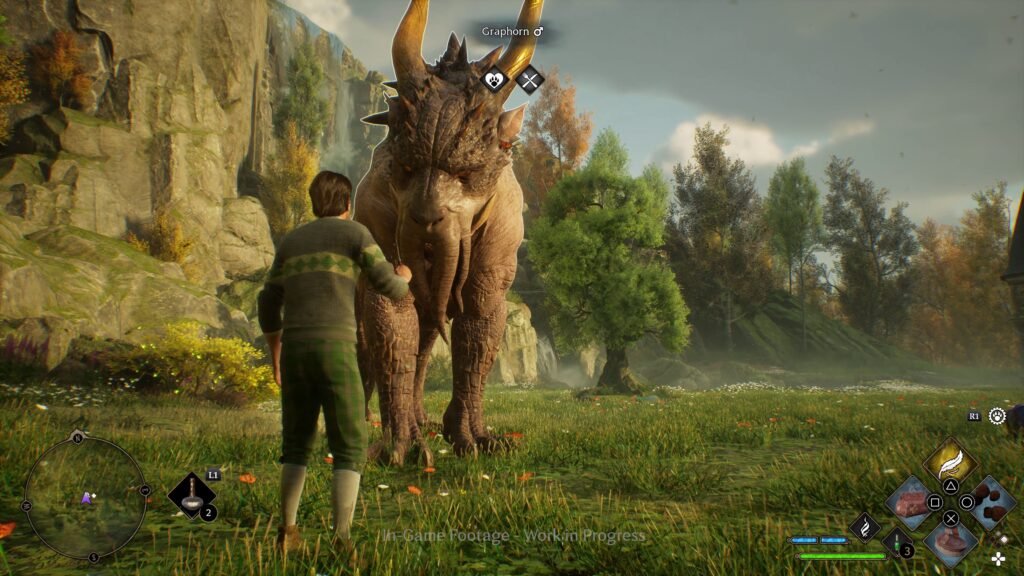
Like many, I’ve been waiting for a truly excellent Harry Potter game since I was in third grade. There have been some decent attempts, but none that have fully captured the magic of receiving your Hogwarts admission letter. With Hogwarts Legacy, I’m happy to say that the magic has finally been brought to life.
The open-world map perfectly captures the vibe of Hogwarts School of Witchcraft and Wizardry. It features exhilarating spell-casting combat, a cast of charming and unforgettable characters, and is packed with countless activities that will keep you busy for dozens of hours. While it may not be the most technically impressive game, and it suffers from a lack of enemy variety, Hogwarts Legacy’s issues can’t overshadow its success in bringing the wizarding world to life.
In true Harry Potter fashion, the plot of Hogwarts Legacy has its share of inconsistencies, often requiring you to just roll with it. The story kicks off with your character transferring to Hogwarts as a fifth-year student for reasons that aren’t fully explained. From there, you’ll attend classes, fight giant spiders, and get wrapped up in a battle between wizards and an evil goblin. The game offers a fantastic character creator, allowing you to craft your perfect witch or wizard, and soon after, you’re thrust into an ongoing magical conflict.
To make matters even more interesting, your character discovers that they have extraordinary magical abilities, though the origin and nature of these powers are never fully explained. If you’re like me, you might roll your eyes at the endless lectures from 100-year-old ghosts in paintings, who go on about history and the importance of saving the world. But once that part passes, Hogwarts Legacy redeems itself with a fantastic supporting cast of living characters, making the conflict feel more grounded and enjoyable.
Most of your time will be spent with your classmates, who will become your friends, help you with quests, and assist in honing your magical abilities. Characters like Sebastian, the cocky and morally flexible Slytherin, and Natsai, the clever Gryffindor, are memorable and instantly endearing. Spending time with them and completing their relationship questlines made my time at Hogwarts all the more enjoyable.
Unexpectedly, I even found myself looking forward to interactions with my professors—whether it was Professor Fig, who serves as a mentor and sidekick, or Professor Ronan, the wise-cracking Charms teacher who had me laughing with his playful teasing. Each of these characters feels like an integral part of the school, and you’ll often find them wandering the halls, doing their own thing. You can choose to spend time with your favorites, which adds a nice touch to the Hogwarts experience.
But it’s the world itself that Hogwarts Legacy truly excels at. The game is filled with nearly everything I wanted in a Harry Potter game—and more. You’ll wander the stone-cobbled halls of Hogwarts, discover secret passageways, fly around the Forbidden Forest on a broomstick, and explore dark caves illuminated only by the glow of your Lumos spell. The developers at Avalanche have captured the look and feel of the Wizarding World so brilliantly that simply being there—whether running errands or taking in the scenery—felt magical.
That said, the immersion was occasionally broken by technical hiccups. On PlayStation 5, I experienced framerate inconsistencies, lighting issues, aggressive pop-in when moving quickly, and even a strange loading screen every time I entered a door. It’s understandable, given the vastness of the game world, but the PS5’s promise of eliminating loading screens hasn’t fully been realized here.
As someone who finds the wand-whipping duels in the movies a bit lackluster, I was initially concerned that Hogwarts Legacy’s combat might not hold my attention across the roughly 32 hours it took me to finish the campaign. But I was pleasantly surprised. The combat is fantastic, challenging, and deeply engaging.
It’s much more than just casting spells from a wand. The real fun comes from dodging and countering enemy attacks while chaining together creative combos. For instance, you can use Accio to pull enemies toward you, then ignite them with the close-range Incendio spell, and finish them off with an explosive Bombarda. The spell variety and combat system make each encounter feel dynamic and rewarding.
Chaining together abilities to make your enemies look like total fools never gets old, especially as you unlock talent tree perks that enhance your skills with modifiers. These perks can make your elemental spells fork to nearby enemies or turn into AoE attacks. Many of the combat encounters are legitimately challenging, too. I’ll admit, I died a few times—whether while showing off a new set of spells or by failing to notice a goblin sneaking up behind me.
Improving your skills and experimenting to find which spells work best for you is an entertaining process, filled with trial and error—and the occasional maiming. There’s even a perfect parry mechanic that’s just begging to be mastered by players like me, always chasing that extra dopamine hit from a perfectly timed block at the last possible second. You’ll also need to change up your tactics regularly, as many enemies come with color-coded shields that can only be broken by spells of a specific type.
For example, enemies with a red shield won’t be damaged until you hit them with a fire-based spell, so you’ll need to keep a few of those handy. While the combat system remains fun, the variety of creatures you face can become repetitive. You’ll fight dark wizards, spiders, and goblins for the bulk of the game, with occasional appearances from trolls or magical suits of armor, but the variety of enemies quickly starts to feel limited.
When you’re not setting spiders on fire, there’s plenty of lighter activities to enjoy, and it’s kind of crazy just how many side tasks Legacy offers. You can spend hours decorating your personal space in the Room of Requirement, catch and breed fantastic beasts (if you know where to find them), practice gardening or potion-making, go shopping in Hogsmeade, or even become a champion duelist in an underground arena with your classmates. You can also dive into the dark arts and learn forbidden spells like the Killing Curse (though, as you’d expect, things don’t go particularly well if you go down that path).

It’s easy to lose track of time in Hogwarts Legacy—in fact, I often found it hard to focus on my original objective because of the many distractions. One of the best ways to forget about the goblin threat in the main story is by diving into the over 100 side quests scattered across the game.
Not all of these side quests are equally exciting. Some are your typical “go here, kill this, collect that” errands, but many feature memorable characters asking for your help with personal problems or mischievous schemes. And you’re often rewarded handsomely for your efforts—whether it’s gear that improves your stats, cosmetic items to enhance your appearance, or, best of all, new spells, which are the ultimate incentive in a game where what you can do is limited by the spells you know.
For example, one side quest unlocks the Alohomora spell, which, in true Metroidvania fashion, lets you unlock doors and access previously unreachable areas. Collecting spells not only opens up more of the map but also gives you a wider range of combat options. I found myself eagerly chasing after these game-changing abilities, desperate to get my hands on as many as possible. The gear you find in Legacy doesn’t allow for full character builds, but it does offer resistances and buffs, and you can spend time upgrading and modifying your favorite items for small improvements.
None of the gear upgrades are groundbreaking, but they were enough to capture my attention and keep me engaged. Of course, the real loop of the game is about cosmetics—something that Legacy fully embraces. You’ll find stylish clothes hidden all over the world, and while these don’t affect gameplay, customizing my Slytherin character to outshine the kids from the other houses was more than enough motivation for me.
The best part is that you can overwrite the appearance of any gear with the look of anything you’ve acquired so far, which is fantastic.
In nearly every way, Hogwarts Legacy is the Harry Potter RPG I’ve always wanted to play. Its open-world adventure captures the excitement and wonder of the wizarding world, with memorable new characters, challenging and nuanced combat, and an expertly crafted Hogwarts student fantasy that kept me glued to my controller for dozens of hours.
It’s certainly weighed down by technical issues, an unremarkable but harmless main story, and limited enemy variety, but even those flaws couldn’t break the enchanting spell it cast on me.